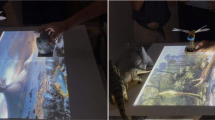Abstract
A multitude of methods for evaluating the interaction and experience exists, but there is a lack of discussion on methods that evaluate the experience in enactive and socioenactive scenarios. In this work, we investigate whether current evaluation methods are sufficient to evaluate the socioenactive experience that emerges of the coupling of three main elements (physical, digital, and social) as part of those scenarios. We conducted a case study to evaluate the experience resulting from the interaction with TangiTime, a tangible tabletop installation, using the AttrakDiff questionnaire as an evaluation method for the socioenactive experience. Based on findings from this case study, we provide insights on other design aspects to be covered in the evaluation of socioenactive scenarios.
Access this chapter
Tax calculation will be finalised at checkout
Purchases are for personal use only
Similar content being viewed by others
References
Weiser, M.: The Computer for the 21st Century. SIGMOBILE Mob. Comput. Commun. Rev. 3(3), 3–11 (1999)
Varela, F.J., Thompson, E., Rosch, E.: The Embodied Mind: Cognitive Science and Human Experience (Revised Edition). MIT Press (2016)
Kaipainen, M., Ravaja, N., Tikka, P., Vuori, R., Pugliese, R.: Enactive systems and enactive media: embodied human-machine coupling beyond interfaces. Leonardo 44(5), 433–443 (2011)
Baranauskas, M.C.C.: Socio-Enactive systems: investigating new dimensions in the design of interaction mediated by information and communication technologies. FAPESP Thematic Project (2015/165280) (2015)
Ishii, H.: Tangible bits: beyond pixels. In: Proceedings of the Second International Conference on Tangible and Embedded Interaction (TEI 2008), pp. 2175–2185. ACM, New York (2008). https://doi.org/10.1145/1347390.1347392
Hassenzahl, M., Burmester, M., Koller, F.: AttrakDiff: Ein Fragebogen zur Messung wahrgenommener hedonischer und pragmatischer Qualitat. In: Szwillus, G., Ziegler, J., Mensch & Computer 2003: Interaktion in Bewegung, pp. 187–196. Vieweg+Teubner Verlag, Wiesbaden (2003)
Mendoza, Y.L.M., Baranauskas, M.C.C.: TangiTime: Designing a (Socio)enactive Experience for Deep Time in an Educational Exhibit. In: XVIII Simpósio Brasileiro sobre Fatores Humanos em Sistemas Computacionais (IHC 2019). ACM, New York (2019). https://doi.org/10.1145/3357155.3358451
Bérigny, C., Gough, P., Faleh, M., Woolsey, E.: Tangible user interface design for climate change education in interactive installation art. Leonardo 47, 451–456 (2014). https://doi.org/10.1162/LEON_a_00710
Chu, J.H., Clifton, P., Harley, D., Pavao, J., Mazalek, A.: Mapping place: supporting cultural learning through a Lukasa-inspired tangible tabletop museum exhibit. In: Proceedings of the Ninth International Conference on Tangible, Embedded, and Embodied Interaction (TEI 2015), pp. 261–268. ACM, New York (2015). https://doi.org/10.1145/2677199.2680559
Ma, J., Sindorf, L., Liao, I., Frazier, J.: Using a tangible versus a multi-touch graphical user interface to support data exploration at a museum exhibit. In: Proceedings of the Ninth International Conference on Tangible, Embedded, and Embodied Interaction (TEI’15), pp. 33–40. ACM, New York, USA (2015). https://doi.org/10.1145/2677199.2680555
Morita, Y., Setozaki, N.: Learning by tangible learning system in science class. In: Kurosu, M. (ed.) HCI 2017. LNCS, vol. 10272, pp. 341–352. Springer, Cham (2017). https://doi.org/10.1007/978-3-319-58077-7_27
Loparev, A., et al.: BacPack: exploring the role of tangibles in a museum exhibit for bio-design. In: Proceedings of the 11th International Conference on Tangible, Embedded, and Embodied Interaction (TEI 2017), pp. 111–120. ACM, New York (2017). https://doi.org/10.1145/3024969.3025000
De Raffaele, C., Smith, S., Gemikonakli, O.: An active tangible user interface framework for teaching and learning artificial intelligence. In: 23rd International Conference on Intelligent User Interfaces (IUI 2018), pp. 535–546. ACM, New York (2018). https://doi.org/10.1145/3172944.3172976
Díaz-Oreiro, I., López, G., Quesada, L., Guerrero, L.A.: Standardized questionnaires for user experience evaluation: a systematic literature review. In: Proceedings of the 13th International Conference on Ubiquitous Computing and Ambient Intelligence (UCAmi), vol. 31, no. 1, p. 14 (2019). https://doi.org/10.3390/proceedings2019031014
Brennand, C.V.L.T., Baranauskas, M.C.C.: Evaluating UX - case studies in socio-enactive scenarios. In: Sánchez, J. (ed.) TISE 2018, Nuevas Ideas en Informática Educativa, vol. 14, pp. 260–271. ACM (2018)
AttrakDiff. http://www.attrakdiff.de/index-en.html. Accessed 2019
Acknowledgments
This work is supported by the São Paulo Research Foundation (FAPESP) (grant #2015/16528-0), National Council for Scientific and Technological Development (CNPq) (grant #306272/2017-2), Coordination for the Improvement of Higher Education Personnel (CAPES) (grant #2017/173989) and a Technical Training Program (grant #2020/03503-7). The authors thank the members of the InterHAD group for their collaboration in different phases of the study and the NIED for providing us the location to conduct the study.
Author information
Authors and Affiliations
Corresponding author
Editor information
Editors and Affiliations
Rights and permissions
Copyright information
© 2020 Springer Nature Switzerland AG
About this paper
Cite this paper
Mendoza, Y.L.M., Baranauskas, M.C.C. (2020). Evaluating the Socioenactive Experience with a Tangible Tabletop Installation: A Case Study. In: Agredo-Delgado, V., Ruiz, P.H., Villalba-Condori, K.O. (eds) Human-Computer Interaction. HCI-COLLAB 2020. Communications in Computer and Information Science, vol 1334. Springer, Cham. https://doi.org/10.1007/978-3-030-66919-5_13
Download citation
DOI: https://doi.org/10.1007/978-3-030-66919-5_13
Published:
Publisher Name: Springer, Cham
Print ISBN: 978-3-030-66918-8
Online ISBN: 978-3-030-66919-5
eBook Packages: Computer ScienceComputer Science (R0)




